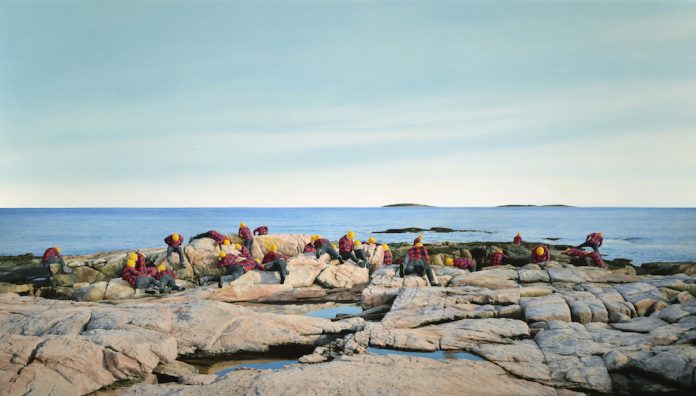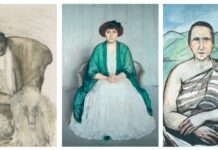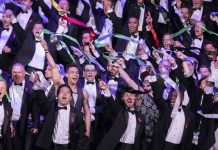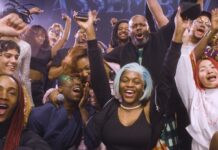It seems fitting that for its first post-pandemic public exhibition, the Shelburne Museum in Shelburne, Vermont will showcase New England by celebrating the region’s people and featuring a number of LGBTQ artists.
“New England Now: People” is a multi-media group exhibition of 10 accomplished artists representing each of New England’s six states. The timely show explores issues of identity, historical and cultural representation, and self-image as it highlights the diversity of the region’s inhabitants.
Organized by associate curator Carolyn Bauer, “New England Now: People” is on view at Shelburne Museum’s Pizzagalli Center for Art and Education’s Murphy Gallery now to October 17.
Bauer explains that the show grew out of the museum’s 2018 exhibition “New England Now,” which focused on painting and photographs depicting the region’s rural and urban landscapes. Bauer immediately started working on a second installment of the New England series, this time with the idea that the show would highlight the “people and communities that shape and define” the region. “It became increasingly important to me that the participating artists and their works reflect New England, and by extension our nation, celebrating diversity and equity,” Bauer says.
Since it was delayed by COVID-19 closures, the exhibit has now taken on a more celebratory nature. Bauer says she thinks of the show as a portrait of New England that illustrates “the conversations we are having about identity, equity and inclusion and how art can allow you to be seen.”
Being seen is foremost in the work of Toby MacNutt, a queer, nonbinary trans and disabled dancer-choreographer, author and teacher living in Burlington, Vermont. MacNutt’s color photographs of acrobatic dancers using fabric and moving with crutches showcase the human form and explore notions of masculinity and physicality. MacNutt’s bold images are “incredibly powerful and lyrical,” says Bauer. MacNutt will perform live at the museum in July; the performance will play on a loop in conjunction with the photographs.
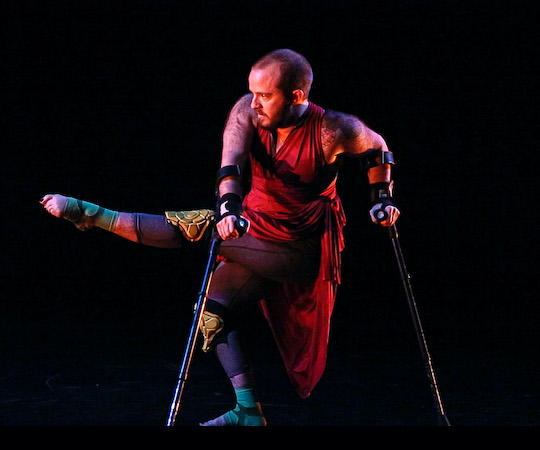
The series of landscape paintings called “Bois Just Wanna Have Fun” by Cobi Moules examines queer and trans identity. Starting in 2008 in Boston, Moules created the paintings from his travels across the United States, paying homage to the traditions of the “Great American Landscape” as envisioned by the Hudson River School painters but with a twist. The focus is more on Moules himself who populates each landscape including Maine’s rocky coast. Bauer notes that this offers a commentary on what is “natural” and how nature can provide a safe haven.
Conceptual realist painter Kate Gridley of Middlebury, Vermont is represented by a triptych of near life-sized portraits of three young people: a queer woman, a Black man and an Asian woman, each one reflecting the artist’s insights into humanity. The paintings will be accompanied by an audio track that introduces viewers to the subjects and their worlds.
Evie Lovett of Putney, Vermont, from 2002 to 2004, photographed drag queens preparing backstage for the monthly drag show at the now-defunct Rainbow Cattle Co. in Dummerston, Vermont. The intimate black-and-white photographs are about transformation and community as well as a celebration of the LGBTQ spaces, particularly those that no longer exist. Lovett’s images will also have accompanying interviews with the subjects.
The works of other artists in the show offer examinations of topics such as immigration and identity. Providence’s Annu Palakunnathu Matthew, an Indian American, draws from her experience of having lived between cultures. She creates thoughtful black-and-white images that echo historical photos. Matthew juxtaposes portraits of people from India with early 18th- and 19th-century photographs of Native Americans.
Melonie Bennett takes an almost anthropological approach in her black-and-white photographs of her family at work and at play in and around her home in Gorham, Maine, creating a revealing and compelling visual diary.
Questions about social identity are intrinsic to the work of Boston painter Sammy Chong, who is Chinese and a native of Ecuador. His mixed-media paintings couple images of South American religious and cultural masks with people laboring in a variety of service jobs. The images are a powerful commentary on cultural bias and preconceptions of identity.
Margaret Jacobs of Hanover, New Hampshire is a Native American artist and member of the Akwesasne Mohawk tribe who works in metals, creating sculptures and jewelry that draw on her cultural heritage. The sculptural objects in the show are a reminder of Mohawk ironworkers who left their tribes and communities to help build structures.
Providence, Rhode Island interdisciplinary artist Nafis White’s designs encompass cultural, social and political ideas. For this show, she is constructing a large hair weaving which Bauer describes as a “detailed and complex” piece that echoes Victorian era hair wreaths as it comments on ancestry, identity and traditions of Black beauty and self-care.
Erik Williams of Hartford, Connecticut, is an acclaimed street photographer whose crisp, intimate black-and-white portraits capture the everyday people he encounters on the streets of his hometown of Hartford. The candid photographs convey grittiness, struggle, hope and sometimes humor as Williams captures individuals in all their humanity.
Bauer sees “New England Now: People” and the diverse artists represented in it as inextricably linked to the events that shaped 2020. “The pandemic and the reckoning around racial injustice and equity make this exhibition’s conversations and voices more salient now than ever,” she says.
More: www.shelburnemuseum.org
Not a subscriber? Sign up today for a free subscription to Boston Spirit magazine, New England’s premier LGBT magazine. We will send you a copy of Boston Spirit 6 times per year and we never sell/rent our subscriber information. Click HERE to sign up!


